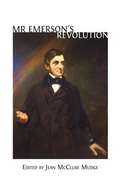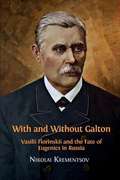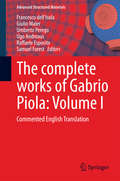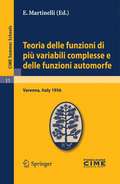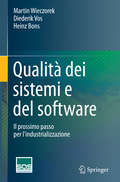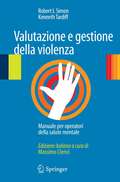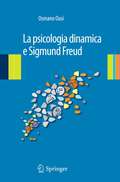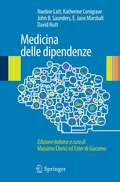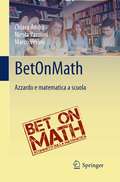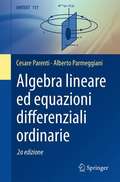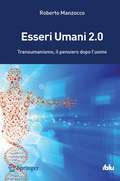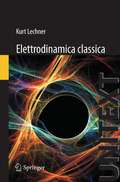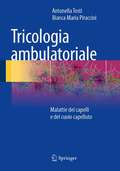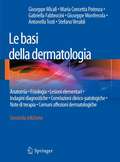- Table View
- List View
Digital Scholarly Editing: Theories And Practices (Digital Humanities Ser. #Vol. 4)
by Matthew Driscoll Elena PierazzoThis volume presents the state of the art in digital scholarly editing. Drawing together the work of established and emerging researchers, it gives pause at a crucial moment in the history of technology in order to offer a sustained reflection on the practices involved in producing, editing and reading digital scholarly editions—and the theories that underpin them. The unrelenting progress of computer technology has changed the nature of textual scholarship at the most fundamental level: the way editors and scholars work, the tools they use to do such work and the research questions they attempt to answer have all been affected. Each of the essays in Digital Scholarly Editing approaches these changes with a different methodological consideration in mind. Together, they make a compelling case for re-evaluating the foundation of the discipline—one that tests its assertions against manuscripts and printed works from across literary history, and the globe. The sheer breadth of Digital Scholarly Editing, along with its successful integration of theory and practice, help redefine a rapidly-changing field, as its firm grounding and future-looking ambit ensure the work will be an indispensable starting point for further scholarship. This collection is essential reading for editors, scholars, students and readers who are invested in the future of textual scholarship and the digital humanities.
Mr. Emerson's Revolution
by Jean McClure MudgeThis volume traces the life, thought and work of Ralph Waldo Emerson, a giant of American intellectual history, whose transforming ideas greatly strengthened the two leading reform issues of his day: abolition and women’s rights. A broad and deep, yet cautious revolutionary, he spoke about a spectrum of inner and outer realities—personal, philosophical, theological and cultural—all of which gave his mid-career turn to political and social issues their immediate and lasting power. This multi-authored study frankly explores Emerson's private prejudices against blacks and women while he also publicly championed their causes. Such a juxtaposition freshly charts the evolution of Emerson's slow but steady application of his early neo-idealism to emancipating blacks and freeing women from social bondage. His shift from philosopher to active reformer had lasting effects not only in America but also abroad. In the U.S. Emerson influenced such diverse figures as Thoreau, Whitman, Dickinson and William James and in Europe Mickiewicz, Wilde, Kipling, Nietzsche, and Camus in Europe as well as many leading followers in India and Japan. The book includes over 170 illustrations, among them eight custom-made maps of Emerson's haunts and wide-ranging lecture itineraries as well as a new four-part chronology of his life placed alongside both national and international events as well as major inventions. Mr. Emerson's Revolution provides essential reading for students and teachers of American intellectual history, the abolitionist and women’s rights movement―and for anyone interested in the nineteenth-century roots of these seismic social changes.
Tennyson’s Poems: New Textual Parallels
by R. H. WinnickIn Tennyson’s Poems: New Textual Parallels, R. H. Winnick identifies more than a thousand previously unknown instances in which Tennyson phrases of two or three to as many as several words are similar or identical to those occurring in prior works by other hands—discoveries aided by the proliferation of digitized texts and the related development of powerful search tools over the three decades since the most recent major edition of Tennyson’s poems was published. Each of these instances may be deemed an allusion (meant to be recognized as such and pointing, for definable purposes, to a particular antecedent text), an echo (conscious or not, deliberate or not, meant to be noticed or not, meaningful or not), or merely accidental. Unless accidental, Winnick writes, these new textual parallels significantly expand our knowledge both of Tennyson’s reading and of his thematic intentions and artistic technique. Coupled with the thousand-plus textual parallels previously reported by Christopher Ricks and other scholars, he says, they suggest that a fundamental and lifelong aspect of Tennyson’s art was his habit of echoing any work, ancient or modern, which had the potential to enhance the resonance or deepen the meaning of his poems. The new textual parallels Winnick has identified point most often to the King James Bible, and to such canonical authors as Shakespeare, Milton, Dryden, Pope, Thomson, Cowper, Shelley, Byron, and Wordsworth. But they also point to many authors rarely if ever previously cited in Tennyson editions and studies, including Michael Drayton, Richard Blackmore, Isaac Watts, Erasmus Darwin, John Ogilvie, Anna Lætitia Barbauld, Letitia Elizabeth Landon, John Wilson, and—with surprising frequency—Felicia Hemans. Tennyson’s Poems: New Textual Parallels is thus a major new resource for Tennyson scholars and students, an indispensable adjunct to the 1987 edition of Tennyson’s complete poems edited by Christopher Ricks.
Thomas Annan of Glasgow: Pioneer Of The Documentary Photograph
by Lionel GossmanIn the wake of Glasgow’s transformation in the nineteenth-century into an industrial powerhouse, the "Second City of the Empire,” a substantial part of the old town of Adam Smith degenerated into an overcrowded and disease-ridden slum. The Old Closes and Streets of Glasgow, Thomas Annan’s photographic record of this central section of the city prior to its demolition in accordance with the City of Glasgow Improvements Act of 1866, is widely recognized as a classic of nineteenth-century documentary photography. Annan’s achievement as a photographer of paintings and a portrait and landscape photographer is less widely known. Thomas Annan: Photographer of Victorian Scotland offers a handy, comprehensive and copiously illustrated overview of the full range of the photographer’s work. The book opens with a brief account of the immediate context of Annan’s career as a photographer: the astonishing florescence of photography in Victorian Scotland. Successive chapters deal with each of the main fields of his activity, touching along the way on issues such as the nineteenth-century debate over the status of photography — a mechanical practice or an artistic one? — and the still ongoing controversies surrounding the documentary photograph in particular. While the text itself is intended for the general reader, extensive endnotes amplify particular themes and offer guidance to readers interested in pursuing these themes further.
Vertical Readings in Dante's Comedy
by George Corbett Heather WebbVertical Readings in Dante’s Comedy is a reappraisal of the poem by an international team of thirty-four scholars. Each vertical reading analyses three same-numbered cantos from the three canticles: Inferno i, Purgatorio i and Paradiso i; Inferno ii, Purgatorio ii and Paradiso ii; etc. Although scholars have suggested before that there are correspondences between same-numbered cantos that beg to be explored, this is the first time that the approach has been pursued in a systematic fashion across the poem. This collection – to be issued in three volumes – offers an unprecedented repertoire of vertical readings for the whole poem. As the first volume exemplifies, vertical reading not only articulates unexamined connections between the three canticles but also unlocks engaging new ways to enter into core concerns of the poem. The three volumes thereby provide an indispensable resource for scholars, students and enthusiasts of Dante. The volume has its origin in a series of thirty-three public lectures held in Trinity College, the University of Cambridge (2012-2016) which can be accessed at the ‘Cambridge Vertical Readings in Dante’s Comedy’ website. This series would not have been possible without the generosity of certain sponsors: Trinity College; Selwyn College; the Italian Department, University of Cambridge; the Cambridge Italian Research Network (CIRN); the Centre for Medieval Literature (University of Southern Denmark and University of York); the University of Notre Dame; and the School of Languages, Cultures and Societies, University of Leeds.
Vertical Readings in Dante's Comedy: Volume 2
by George Corbett Heather WebbThis collection – to be issued in three volumes – offers an unprecedented repertoire of vertical readings for the whole poem. As the first volume exemplifies, vertical reading not only articulates unexamined connections between the three canticles but also unlocks engaging new ways to enter into core concerns of the poem. The three volumes thereby provide an indispensable resource for scholars, students and enthusiasts of Dante. The volume has its origin in a series of thirty-three public lectures held in Trinity College, the University of Cambridge (2012-2016) which can be accessed at the Cambridge Vertical Readings in Dante’s Comedy website.
Vertical Readings in Dante's Comedy: Volume 3
by George Corbett Heather WebbVertical Readings in Dante’s Comedy is a reappraisal of the poem by an international team of thirty-four scholars. Each vertical reading analyses three same-numbered cantos from the three canticles: Inferno i, Purgatorio i and Paradiso i; Inferno ii, Purgatorio ii and Paradiso ii; etc. Although scholars have suggested before that there are correspondences between same-numbered cantos that beg to be explored, this is the first time that the approach has been pursued in a systematic fashion across the poem. This collection in three volumes offers an unprecedented repertoire of vertical readings for the whole poem. As the first volume exemplifies, vertical reading not only articulates unexamined connections between the three canticles but also unlocks engaging new ways to enter into core concerns of the poem. The three volumes thereby provide an indispensable resource for scholars, students and enthusiasts of Dante. The volume has its origin in a series of thirty-three public lectures held in Trinity College, the University of Cambridge (2012-2016) which can be accessed at the Cambridge Vertical Readings in Dante’s Comedy website.
With and Without Galton: Vasilii Florinskii And The Fate Of Eugenics In Russia
by Nikolai KrementsovIn 1865, British polymath Francis Galton published his initial thoughts about the scientific field that would become ‘eugenics.’ The same year, Russian physician Vasilii Florinskii addressed similar issues in a sizeable treatise, entitled Human Perfection and Degeneration. Initially unheralded, Florinskii’s book would go on to have a remarkable afterlife in twentieth- and twenty-first-century Russia. In this lucid and insightful work, Nikolai Krementsov argues that the concept of eugenics brings together ideas, values, practices, and fears energised by a focus on the future. It has proven so seductive to different groups over time because it provides a way to grapple with fundamental existential questions of human nature and destiny. With and Without Galton develops this argument by tracing the life-story of Florinskii’s monograph from its uncelebrated arrival amid the Russian empire’s Great Reforms, to its reissue after the Bolshevik Revolution, its decline under Stalinism, and its subsequent resurgence: first, as a founding document of medical genetics, and most recently, as a manifesto for nationalists and racial purists. Krementsov’s meticulously researched ‘biography of a book’ sheds light not only on the peculiar fate of eugenics in Russia, but also on its convoluted transnational history, elucidating the field’s protean nature and its continuing and contested appeal to diverse audiences, multiple local trajectories, and global trends. It is required reading for historians of eugenics, science, medicine, education, literature, and Russia, and it will also appeal to the general reader looking for a deeper understanding of this challenging subject. Victoria College, University of Toronto, has generously contributed to the publication of this volume.
The Pogroms in Ukraine, 1918-19
by Nokhem Shtif Maurice WolfthalBetween 1918 and 1921 an estimated 100,000 Jewish people were killed, maimed or tortured in pogroms in Ukraine. Hundreds of Jewish communities were burned to the ground and hundreds of thousands of people were left homeless and destitute, including orphaned children. A number of groups were responsible for these brutal attacks, including the Volunteer Army, a faction of the Russian White Army. The Pogroms in Ukraine, 1918-19: Prelude to the Holocaust is a vivid and horrifying account of the atrocities committed by the Volunteer Army, written by Nokhem Shtif, an eminent Yiddish linguist and social activist who joined the relief efforts on behalf of the pogrom survivors in Kiev. Shtif’s testimony, published in 1923, was born from his encounters there and from the weighty archive of documentation amassed by the relief workers. This was one of the earliest efforts to systematically record human rights atrocities on a mass scale. Originally written in Yiddish and here skillfully translated and introduced by Maurice Wolfthal, The Pogroms in Ukraine, 1918-19 brings to light a terrible and historically neglected series of persecutions that foreshadowed the Holocaust by twenty years. It is essential reading for academics and students in the fields of human rights, Jewish studies, Russian and Soviet studies, and Ukraine studies.
Woodstock Scholarship: An Interdisciplinary Annotated Bibliography
by Jeffrey N. GattenSince August 1969, the Woodstock Music and Art Fair looms large when recounting the history and impact of the baby boom generation and the societal upheavals of the Sixties. Scholars study the sociological, political, musical, and artistic impact of the event and use it as a cultural touchstone when exploring alternative perspectives or seeking clarity. This interdisciplinary annotated bibliography records the details of over 400 English-language resources on the Festival, including books, chapters, articles, websites, transcriptions and videos. Divided into six main subsections―Culture & Society, History, Biography, Music, Film, Arts & Literature―for ease of consultation Woodstock Scholarship sheds light on all facets of a key happening in our collective history. Throughout the 1960s, popular music became increasingly reflective and suggestive of the rising political and social consciousness of the youth culture. Examples can be seen in the development of the protest song genre within the folk music boom of the early Sixties and the marriage of lifestyle to music first reflected by The Beatles with fashion, followed by psychedelic music with the emerging drug culture. Woodstock was where these themes coalesced, thus becoming the defining and last great moment of the 1960s. However, Woodstock also represented an abundant amount of experiences and ideas and moments. Thus, when exploring the complicated accounts and numerous facets of America during the turbulent Sixties one discovers scholarship on the key subjects, such as the Vietnam War or the Civil Rights Movement, often considering and debating the importance, relevance, and epic nature of Woodstock. Multiple narratives emerge: a radical engagement of the hippie movement, an overt commercial exploitation of youth culture, a political statement. Woodstock scholarship does not stand alone as field of study, but it is at the cross-road of a number of disciplines―music history, cultural studies, sociology, arts and literature, media studies, politics and economics. Providing full bibliographical details and concise, informative annotation for each entry, Woodstock Scholarship is an essential tool for students, scholars, teachers, and librarians in all these areas, as well as for anyone seeking a deeper understanding of both the Woodstock Music and Art Fair phenomenon and of the confluence of music, commerce and politics.
Zombies in Western Culture: A Twenty-first Century Crisis
by John Vervaeke Christopher Mastropietro Filip MiscevicWhy has the zombie become such a pervasive figure in twenty-first-century popular culture? John Vervaeke, Christopher Mastropietro and Filip Miscevic seek to answer this question by arguing that particular aspects of the zombie, common to a variety of media forms, a crisis in modern Western culture. The authors examine the essential features of the zombie, including mindlessness, ugliness and homelessness, and argue that these reflect the outlook of the contemporary West and its attendant zeitgeists of anxiety, alienation, disconnection and disenfranchisement. They trace the relationship between zombies and the theme of secular apocalypse, demonstrating that the zombie draws its power from being a perversion of the Christian mythos of death and resurrection. Symbolic of a lost Christian worldview, the zombie represents a world that can no longer explain itself, nor provide us with instructions for how to live within it. The concept of 'domicide' or the destruction of home is developed to describe the modern crisis of meaning that the zombie both represents and reflects. This is illustrated using case studies including the relocation of the Anishinaabe of the Grassy Narrows First Nation, and the upheaval of population displacement in the Hellenistic period. Finally, the authors invoke and reformulate symbols of the four horseman of the apocalypse as rhetorical analogues to frame those aspects of contemporary collapse that elucidate the horror of the zombie. Zombies in Western Culture: A Twenty-First Century Crisis is required reading for anyone interested in the phenomenon of zombies in contemporary culture. It will also be of interest to an interdisciplinary audience including students and scholars of culture studies, semiotics, philosophy, religious studies, eschatology, anthropology, Jungian studies, and sociology.
Just Managing? What it Means for the Families of Austerity Britain
by Mark O’Brien Paul KyprianouThe 'just about managing'. 'Hardworking families'. 'Alarm-clock Britain'. In recent years British political discourse has been filled with these slogans, as politicians claim to speak on behalf of families who are in work, but struggling to get by. This book allows us to hear from some of these families directly. At a time when the impact of austerity is more relevant than ever, Just Managing? cuts through the debates and sloganeering to give some of the real people behind the headlines and statistics a chance to tell their stories. It tracks the lives of thirty working families in Liverpool over one year, as they struggle to manage on incomes at or around the National Minimum Wage. Their accounts are placed within the economic and political context that has shaped their experiences and that of millions of other working families across the country. This book is required reading for anyone seeking to understand what life is like at the sharp end of 'austerity Britain’.
The complete works of Gabrio Piola: Commented English Translation (Advanced Structured Materials #38)
by Francesco Da Dell'Isola Ugo Andreaus Raffaele Esposito Samuel Forest Giulio Maier Umberto PeregoGabrio Piola works had an enormous impact on the development of applied mathematics and continuum mechanics. An excellent scientific committee who took it upon themselves to translate his complete works. In a second step, they commented Piola’s work and compared it to modern theories in mechanics in order to stress Piola’s impact on modern science and proofs that he has set milestones in applied mathematics.This book presents Piola's original Italian text together with ist translations and their comments. It shows impressively that Gabrio Piola’s work must still be regarded as a modern theory.
Samajik Shodh Aur Sankhyiki - IAS, PCS, LLB, B.A and M.A - Ranchi University, N.P.U
by Ravindra MukarjiVivek Social Research And Statistics (Samajik Shodh Aur Sankhyiki) Update 2018 Edition By Dr. Ravindra Nath Mukarji Useful For IAS, PCS, LLB, B.A, and M.A Related Exam.
Teoria delle funzioni di più variabili complesse e delle funzioni automorfe: Lectures given at a Summer School of the Centro Internazionale Matematico Estivo (C.I.M.E.) held in Varenna (Como), Italy, September 3-12, 1956 (C.I.M.E. Summer Schools #11)
by E. MartinelliLectures: B. Eckmann: Cours sur les variétés complexes.- W. Fenchel: Introduzione alla teoria dei gruppi discontinui di trasformazioni.- Seminars: E. Martinelli: Punti di vista geometrici nello studio delle varietà a struttura complessa.- K. Stein: Leçons sur la théorie des fonctions de plusieurs variables complexes.- E. Peschl: Les invariants différentiels dans la théorie des fonctions de plusieurs variables complexes.
Qualità dei sistemi e del software: Il prossimo passo per l'industrializzazione
by Martin Wieczorek Diederik Vos Heinz BonsLa domanda, qual è il contributo che la qualità del software e dei sistemi possono apportare al successo del business di un'azienda e come possiamo garantire la giusta qualità dei sistemi e dei prodotti basati sul software, è una domanda retorica. Come in molti altri settori, anche l'industria del software è in continua trasformazione. Le innovazioni e le nuove soluzioni scaturiscono da nuove esigenze provenienti dai mercati e dalla disponibilità di nuove tecnologie. Già da molti anni l'industria del software è influenzata da un proprio alto tasso di innovazione che ha avuto un impatto su tutte le fasi del ciclo di vita di un software e di un sistema. I cambiamenti che vediamo nel software includono anche la gestione e la garanzia della qualità nel suo insieme. Sebbene alcune best practice siano già ora messe in pratica, c'è molto spazio per migliorare. A nostro avviso, non è ancora presente nel settore IT un approccio olistico alla qualità dei prodotti e dei sistemi software. Deve essere definita in maniera chiara la giusta qualità dei sistemi e dei prodotti basati sul software. Per questo motivo, diamo uno sguardo ai "sistemi integrati" e ai "sistemi IT", impariamo qualcosa da entrambi e discutiamo il nostro approccio per la giusta qualità dei software e dei sistemi (RiSSQ).
Valutazione e gestione della violenza: Manuale per operatori della salute mentale
by Robert I. Simon Kenneth TardiffLa violenza è un aspetto endemico della nostra società ed epidemico della nostra epoca. Valutare e trattare pazienti che hanno ideazioni e comportamenti violenti può essere frustrante, ansiogeno e, addirittura, pericoloso, in quanto eventuali errori di giudizio possono provocare conseguenze disastrose. La valutazione e la gestione adeguata del problema è dunque cruciale per i professionisti della salute mentale che si trovano ad affrontarlo. La presente opera è strutturata per essere uno strumento di supporto e di formazione per queste figure professionali. I vari capitoli prendono in considerazione la diversità del setting clinico, i dati demografici relativi ai pazienti, la psicopatologia e le diverse modalità di trattamento, conferendo al volume la caratteristica di un testo di riferimento non solo per i clinici ma anche per i loro pazienti e per le comunità la cui sicurezza dipende dal giudizio di professionisti competenti.
La psicologia dinamica e Sigmund Freud
by Osmano OasiQuesto volume è pensato contemporaneamente come un’introduzione sia alla psicologia dinamica sia alla psicoanalisi. I primi capitoli, dopo aver mostrato la specificità dell’approccio psicodinamico all’uomo e proposto cenni di diagnosi e nosografia psichiatrica e psicoanalitica, passa in rassegna gli autori appartenenti alla prima psichiatria dinamica, precursori del pensiero di Freud. La parte centrale del volume è interamente dedicata a Freud: lo sviluppo del suo pensiero è descritto tramite un inquadramento storico degli eventi personali e sociali del tempo; particolare attenzione è dedicata ai suoi casi clinici, dei quali sono mostrati quindi gli aspetti tecnici dell’agire psicoanalitico. NEi capitoli finali vengono trattati quegli autori che, insieme a Freud, furono alla base dello sviluppo e della diffusione del pensiero psicoanalitico, a volte contrapponendosi umanamente e scientificamente a lui.
Medicina delle dipendenze
by Noeline Latt Katherine Conigrave John Saunders E. Jane Marshall David J. NuttL’abuso di sostanze può essere alla base di un gran numero di patologie e disturbi psichiatrici, e viene classificato tra i primi quattro fattori di rischio che contribuiscono al carico di malattia globale. Una situazione di dipendenza può infatti complicare un quadro psichiatrico già difficile, poiché si sovrappone ad altri disturbi e talvolta ne prende le forme, rendendo ancora più ardua la valutazione del paziente. Individuare con precisione un disturbo da abuso di sostanze può facilitare la diagnosi clinica, evitare test non necessari e abbreviare la durata del ricovero. Questo volume costituisce una guida pratica e concisa rivolta agli studenti, ai medici e ad altre figure professionali che si confrontano con la moderna medicina della dipendenza. Illustrando una vasta gamma di evidenze, metodi e soluzioni per la gestione del paziente con dipendenza, questa guida fornisce gli strumenti e le conoscenze di base utili a una pratica clinica rapida ed efficace in questo campo.
BetOnMath: Azzardo e matematica a scuola
by Chiara Andrà Nicola Parolini Marco VeraniIl libro ha origine dall'attività svolta durante il progetto "BetOnMath", un'esperienza di Matematica Civile finalizzata alla prevenzione dell'abuso di gioco d'azzardo tra gli studenti della scuola secondaria di secondo grado attraverso un insegnamento innovativo della matematica. In particolare, durante il progetto gli autori del libro hanno sviluppato un percorso didattico modulare sulla matematica del gioco d'azzardo che gli insegnanti di matematica delle scuole secondarie possono utilizzare sia per introdurre gli strumenti di base del calcolo delle probabilità sia per sensibilizzare sui rischi legati al gioco d'azzardo.Il libro descrive i pilastri metodologici e concettuali che hanno guidato la concezione e dato forma al percorso didattico, ovvero la centralità del ruolo dell'insegnante, l'uso dei simulatori di gioco, l'importanza delle attività di gruppo e il ruolo delle emozioni nell'affrontare e comprendere nuovi concetti matematici. Nel libro, ciascuno di questi pilastri è trattato sia mediante una discussione teorica che attraverso la presentazione di specifici esempi tratti da reali situazioni d'aula vissute dagli insegnanti che hanno utilizzato il percorso didattico nelle loro classi. L'ultima parte del libro, scritta in collaborazione con gli esperti di psicologia della dipendenza dell'associazione AND (Azzardo e Nuove Dipendenze), è dedicata ad una indagine volta ad analizzare le attitudini degli studenti di scuola secondaria nei confronti del gioco d'azzardo. L'ampiezza e la varietà del campione analizzato rende tale analisi di particolare rilievo per meglio comprendere il contesto all'interno del quale ha operato il progetto BetOnMath.MOOC: http://betonmath.polimi.it/mooc
Algebra lineare ed equazioni differenziali ordinarie (UNITEXT #117)
by Cesare Parenti Alberto ParmeggianiLa prima parte del presente volume fornisce strumenti dell'algebra lineare nel caso finito dimensionale, ma con la prospettiva infinito-dimensionale, giungendo a trattare argomenti quali funzioni di matrice, equazioni matriciali e matrici dipendenti da parametri.La seconda parte tratta di equazioni/sistemi differenziali ordinari, con particolare enfasi sulla stabilità dei punti di equilibrio e delle orbite periodiche (per esempio il Teorema di Poincaré).Non mancano applicazioni alle equazioni alle derivate parziali (metodo delle caratteristiche ed equazione di Hamilton-Jacobi).La prima parte può essere utilizzata autonomamente, mentre la seconda dipende in parte dai risultati esposti nella prima.Nel testo sono presenti esercizi in forma di verifica di proprietà indicate e, alla fine di ciascuna parte, esercizi volti alla verifica della comprensione degli argomenti trattati ed esercizi riguardanti possibili generalizzazioni.Si tratta di un testo avanzato, rivolto a studenti della laurea magistrale o del dottorato di ricerca.
Esseri Umani 2.0: Transumanismo, il pensiero dopo l'uomo (I blu)
by Roberto ManzoccoIl transumanismo è un movimento filosofico e culturale internazionale che vuole che l'uomo prenda in mano la propria evoluzione biologica tramite l'uso della tecnologia. L'obiettivo finale è quello di raggiungere uno stadio evolutivo "post-umano", in cui noi stessi e i nostri discendenti possiamo godere di una vita lunghissima e di capacità fisiche e mentali superiori a quelle attuali. Un po’ come il “Giano bifronte” della tradizione romana, il movimento transumanista ha due facce, in questo caso una rivolta al presente, ai progressi scientifici e tecnologici attualmente in corso, e l’altra che guarda al mondo che verrà. Il libro costituisce per il lettore un viaggio tra le affermazioni, le idee più concrete e quelle più fantasiose di questi pensatori, ed effettuerà nel contempo un “reality check”, esaminando lo stato dell’arte in ambito tecno-scientifico, andando cioè a vedere che rapporto hanno queste idee con il lavoro e le ricerche degli scienziati non esplicitamente transumanisti.
Elettrodinamica Classica (UNITEXT)
by Kurt LechnerIl libro è un testo di Elettrodinamica classica avanzata e comprende anche le basi della Teoria dei campi classici. Come tale è rivolto a qualsiasi studente o ricercatore di Fisica Teorica. Una caratteristica fondamentale del testo è rappresentata da una derivazione rigorosa dei fenomeni ettromagnetici dalle fondamenta teorico-matematiche della teoria, che mette bene in evidenze le inconsistenze e i limiti interni della teoria. Il testo contiene anche un certo numero di argomenti recenti o speculativi che nei libri di testo vengono affrontati solo superficialmente.
Tricologia ambulatoriale: Malattie dei capelli e del cuoio capelluto
by Antonella Tosti Bianca Maria PiracciniQuesto volume è una guida aggiornata alla diagnosi, alla terapia e alla gestione delle numerose malattie e alterazioni dei capelli e dei peli, e particolare attenzione è stata dedicata a quei disturbi che si è iniziato a studiare da pochi anni e tecniche diagnostiche di recente impiego. Negli ultimi anni la ricerca scientifica ha infatti compiuto notevoli progressi nel campo della tricologia e oggi sono disponibili nuove tecniche diagnostiche e terapie specifiche. Questo testo accompagnerà il dermatologo, il chirurgo plastico e il medico generico nel riconoscimento e nella comprensione delle più frequenti malattie dei capelli e dei peli, fornendo suggerimenti per la gestione corretta del paziente e per la terapia migliore.
Le basi della dermatologia: Anatomia • Fisiologia • Lesioni elementari • Indagini diagnostiche •Correlazioni clinico-patologiche • Note di terapia • Comuni affezioni dermatologiche
by Maria Concetta PotenzaIl testo “Le basi della dermatologia” si propone di condurre il medico all’identificazione e valutazione delle lesioni elementari, nonché alla conoscenza delle più moderne tecniche diagnostiche, per permettere un’interpretazione ragionata e corretta del quadro clinico, senza tralasciare le correlazioni istopatologiche e le appropriate opzioni terapeutiche. L’esatta conoscenza dell’anatomia e della fisiopatologia della cute è infatti fondamentale per un corretto inquadramento clinico-diagnostico del paziente dermatologico. In quest’ottica, è stato aggiunto alla seconda edizione del volume un nuovo capitolo che descrive le più comuni affezioni dermatologiche indicandone in modo sintetico le caratteristiche fondamentali ai fini della diagnosi e dell’impostazione della terapia. Redatto in forma essenziale e didattica, il testo è rivolto a dermatologi e medici di base, come pure a specialisti e specializzandi di branche diverse, quali chirurghi plastici, pediatri, geriatri, endocrinologi, allergologi, nonché a medici estetici e a coloro che desiderino avvicinarsi alla cute e a quanto ad essa correlato.

